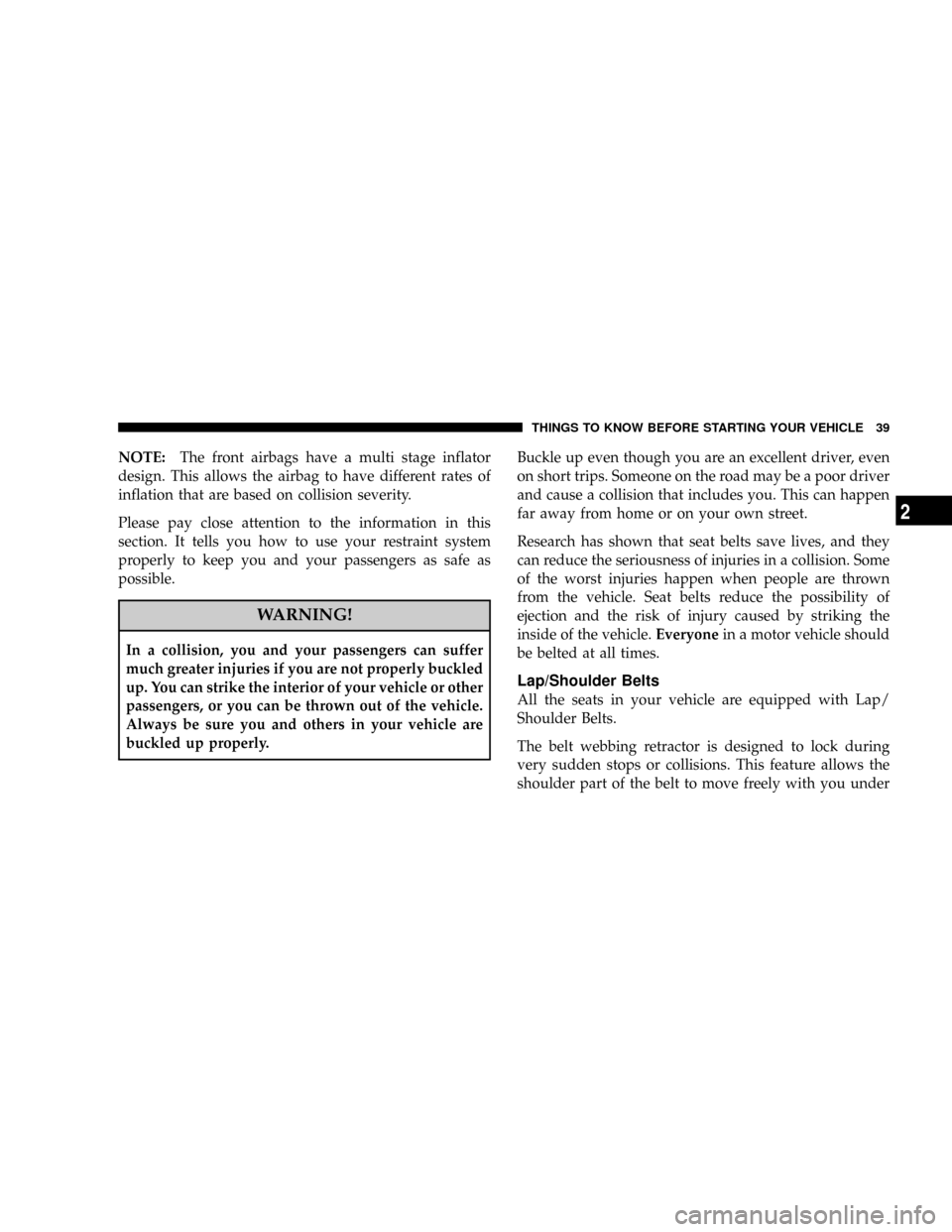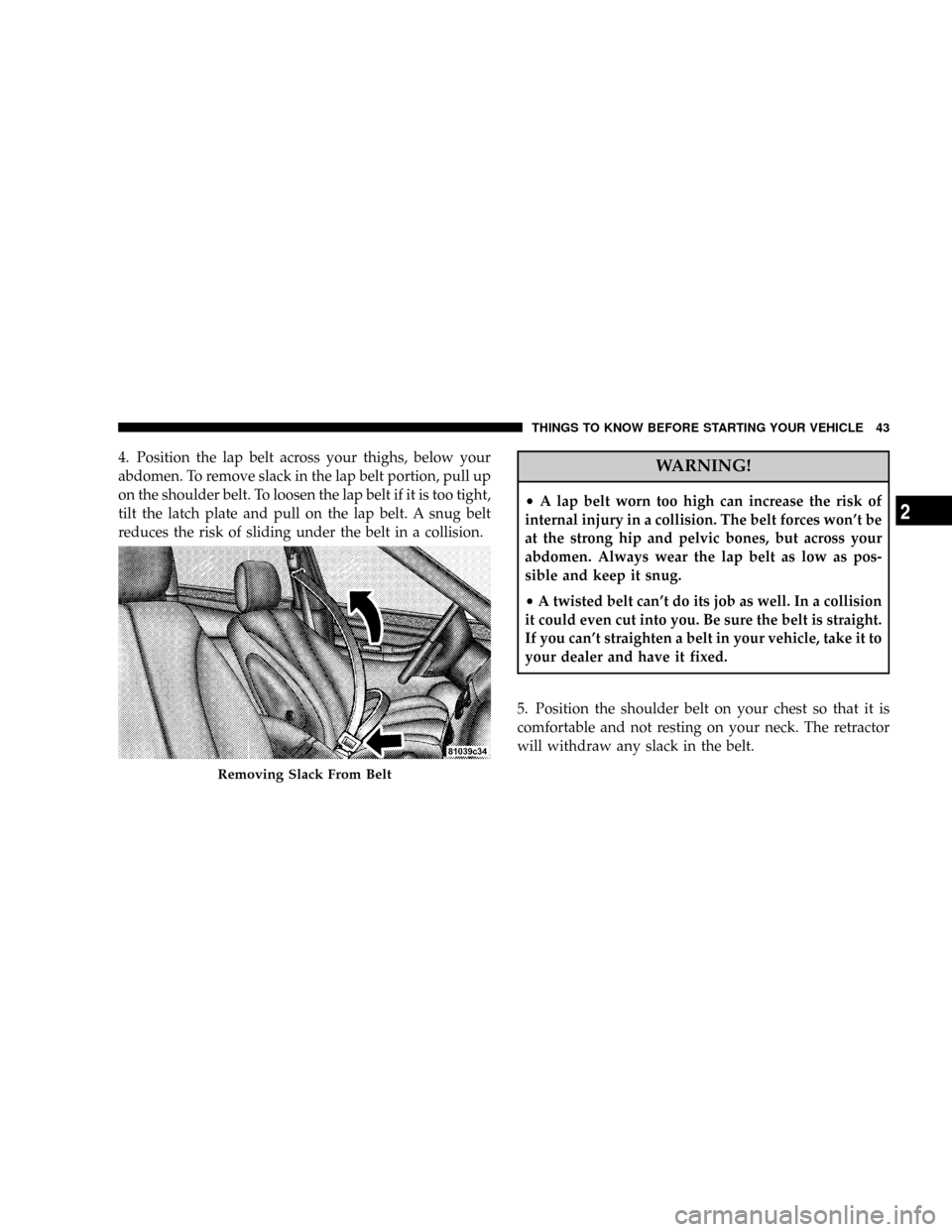belt CHRYSLER PACIFICA 2008 1.G Owners Manual
[x] Cancel search | Manufacturer: CHRYSLER, Model Year: 2008, Model line: PACIFICA, Model: CHRYSLER PACIFICA 2008 1.GPages: 457, PDF Size: 6.7 MB
Page 10 of 457

mIlluminated Entry System..................20
mRemote Keyless Entry.....................20
NTo Unlock The Doors And Liftgate..........21
NTo Lock The Doors And Liftgate............22
NTo Open/Close Power Liftgate Ð If Equipped . .23
NFlash Lights On Lock/Unlock.............23
NUsing The Panic Alarm..................24
NProgramming Additional Transmitters........24
NBattery Replacement....................24
mDoor Locks............................26
NManual Door Locks.....................26
NPower Door Locks.....................27
NChild Protection Door Lock...............30mWindows.............................32
NPower Windows.......................32
mLiftgate...............................34
NPower Liftgate Ð If Equipped.............35
mOccupant Restraints......................38
NLap/Shoulder Belts.....................39
NLap/Shoulder Belt Untwisting Procedure.....45
NSeat Belt Pretensioners...................47
NEnhanced Seat Belt Use Reminder System
(BeltAlert)...........................47
NSeat Belts And Pregnant Women............48
NAutomatic-Locking Retractor (ALR).........49
NSeat Belts And Pregnant Women............49
10 THINGS TO KNOW BEFORE STARTING YOUR VEHICLE
Page 11 of 457

NSeat Belt Extender......................49
NDriver And Front Passenger Supplemental
Restraint System - Airbag................50
NEvent Data Recorder (EDR)...............65
NChild Restraint........................67
mEngine Break-In Recommendations...........77mSafety Tips............................78
NExhaust Gas..........................78
NSafety Checks You Should Make Inside The
Vehicle..............................79
NPeriodic Safety Checks You Should Make
Outside The Vehicle....................80
THINGS TO KNOW BEFORE STARTING YOUR VEHICLE 11
2
Page 28 of 457

If desired, the ªAuto Door Locks?º feature can be turned
on or off by using the following procedure:
²On electronic vehicle information center (EVIC)
equipped vehicles refer to ªAuto Door Locks?º under
ªUse Factory Settings?º in the EVIC section of this
manual.
²On non EVIC - equipped vehicles perform the follow-
ing steps:
Auto Door Locks Programming
1. Enter your vehicle and close all doors.
2. Fasten your seat belt (Fastening the seat belt will
cancel any chiming that may confuse you during this
programming procedure).
3. Place the key into the ignition.4. Within 15 seconds cycle the key from the LOCK
position to the ON/RUN position a minimum of four
times; ending in the LOCK position(Do not start the
engine).
5. Within 30 seconds, press the driver's door lock switch
in the LOCK direction.
6. A single chime will be heard to indicate the feature has
been disabled.
7. To reactivate this feature, repeat the above steps.
8. If a chime is not heard, program mode was canceled
before the feature could be disabled. If necessary, repeat
this procedure.
Auto Unlock On Exit Ð If Equipped
This feature unlocks all of the doors of the vehicle when
any door is opened. This will occur only after the vehicle
has been driven (shifted out of Park with all doors
closed) and then shifted back into the Park position.
28 THINGS TO KNOW BEFORE STARTING YOUR VEHICLE
Page 29 of 457

This feature will not operate if there is any manual
operation of the power door locks (Lock or Unlock). If
desired, the ªAuto Unlock On Exit?º feature can be
turned on or off by using the following procedure:
²On electronic vehicle information center (EVIC)
equipped vehicles refer to ªAuto Unlock On Exit?º
under ªUse Factory Settings?º in the EVIC section of
this manual.
²On non EVIC - equipped vehicles perform the follow-
ing steps:
Auto Unlock On Exit Programming
1. Enter your vehicle and close all doors.
2. Fasten your seat belt (fastening the seat belt will cancel
any chimes that may be confusing during this program-
ming procedure).
3. Insert the key into the ignition.4. Within 15 seconds, cycle the key from the LOCK
position to the ON/RUN position a minimum of four
times ending in the LOCK position(do not start the
engine).
5. Within 30 seconds, press the driver's door lock switch
in the UNLOCK direction.
6. A single chime will sound to indicate the feature has
been changed.
7. Repeat the above steps to alternate the availability of
this feature.
8. If a chime is not heard, program mode was canceled
before the feature could be changed. If necessary repeat
this procedure.
NOTE:Use the Auto Door Locks and Auto Unlock
features in accordance with local laws.
THINGS TO KNOW BEFORE STARTING YOUR VEHICLE 29
2
Page 38 of 457

Gas props support the liftgate in the open position.
However, because the gas pressure drops with tempera-
ture, it may be necessary to assist the props when
opening the liftgate in cold weather.
OCCUPANT RESTRAINTS
Some of the most important safety features in your
vehicle are the restraint systems. These include the front
and rear seat belts for the driver and all passengers, front
airbags for both the driver and front passenger, and if
equipped, left and right window bags for the driver and
passengers seated next to a window and a driver inflat-
able knee blocker. If you will be carrying children too
small for adult-size seat belts, your seat belts or the
LATCH feature (refer to the Child Restraint section in this
manual), can be used to hold infant and child restraint
systems.If your vehicle is equipped with the Occupant Classifi-
cation System (OCS) there will be a Passenger Airbag
Disabled (PAD) Indicator Light located on the center of
the instrument panel.
Passenger Airbag Light Ð If OCS Equipped
38 THINGS TO KNOW BEFORE STARTING YOUR VEHICLE
Page 39 of 457

NOTE:The front airbags have a multi stage inflator
design. This allows the airbag to have different rates of
inflation that are based on collision severity.
Please pay close attention to the information in this
section. It tells you how to use your restraint system
properly to keep you and your passengers as safe as
possible.
WARNING!
In a collision, you and your passengers can suffer
much greater injuries if you are not properly buckled
up. You can strike the interior of your vehicle or other
passengers, or you can be thrown out of the vehicle.
Always be sure you and others in your vehicle are
buckled up properly.Buckle up even though you are an excellent driver, even
on short trips. Someone on the road may be a poor driver
and cause a collision that includes you. This can happen
far away from home or on your own street.
Research has shown that seat belts save lives, and they
can reduce the seriousness of injuries in a collision. Some
of the worst injuries happen when people are thrown
from the vehicle. Seat belts reduce the possibility of
ejection and the risk of injury caused by striking the
inside of the vehicle.Everyonein a motor vehicle should
be belted at all times.
Lap/Shoulder Belts
All the seats in your vehicle are equipped with Lap/
Shoulder Belts.
The belt webbing retractor is designed to lock during
very sudden stops or collisions. This feature allows the
shoulder part of the belt to move freely with you under
THINGS TO KNOW BEFORE STARTING YOUR VEHICLE 39
2
Page 40 of 457

normal conditions. But in a collision, the belt will lock
and reduce the risk of your striking the inside of the
vehicle or being thrown out.
WARNING!
²It is extremely dangerous to ride in a cargo area,
inside or outside of a vehicle. In a collision, people
riding in these areas are more likely to be seri-
ously injured or killed.
²Do not allow people to ride in any area of your
vehicle that is not equipped with seats and seat
belts.
²Be sure everyone in your vehicle is in a seat and
using a seat belt properly.
WARNING!
²Wearing a seat belt incorrectly is dangerous. Seat
belts are designed to go around the large bones of
your body. These are the strongest parts of your
body and can take the forces of a collision the best.
²Wearing your belt in the wrong place could make
your injuries in a collision much worse. You might
suffer internal injuries, or you could even slide out
of part of the belt. Follow these instructions to
wear your seat belt safely and to keep your pas-
sengers safe, too.
²Two people should never be belted into a single
seat belt. People belted together can crash into one
another in a collision, hurting one another badly.
Never use a lap/shoulder belt or lap belt for more
than one person, no matter what their size.
40 THINGS TO KNOW BEFORE STARTING YOUR VEHICLE
Page 41 of 457

Lap/Shoulder Belt Operating Instructions
1. Enter the vehicle and close the door. Sit back and
adjust the seat.
2. The seat belt latch plate is near the seatback of the
front seats and next to your arm in the rear seats. Grasp
the latch plate and pull out the belt. Slide the latch plate
up the webbing as far as necessary to allow the belt to go
around your lap.
Pulling Out Lap/Shoulder Belt
THINGS TO KNOW BEFORE STARTING YOUR VEHICLE 41
2
Page 42 of 457

3. When the belt is long enough to fit, insert the latch
plate into the buckle until you hear a ªclickº.WARNING!
²A belt that is buckled into the wrong buckle will not
protect you properly. The lap portion could ride too high
on your body, possibly causing internal injuries. Always
buckle your belt into the buckle nearest you.
²A belt that is too loose will not protect you as well. In a
sudden stop you could move too far forward, increasing
the possibility of injury. Wear your seat belt snugly.
²A belt that is worn under your arm is very dangerous.
Your body could strike the inside surfaces of the vehicle
in a collision, increasing head and neck injury. A belt
worn under the arm can cause internal injuries. Ribs
aren't as strong as shoulder bones. Wear the belt over your
shoulder so that your strongest bones will take the force
in a collision.
²A shoulder belt placed behind you will not protect you
from injury during a collision. You are more likely to hit
your head in a collision if you do not wear your shoulder
belt. The lap and shoulder belt are meant to be used
together.
Connecting Latch Plate To Buckle
42 THINGS TO KNOW BEFORE STARTING YOUR VEHICLE
Page 43 of 457

4. Position the lap belt across your thighs, below your
abdomen. To remove slack in the lap belt portion, pull up
on the shoulder belt. To loosen the lap belt if it is too tight,
tilt the latch plate and pull on the lap belt. A snug belt
reduces the risk of sliding under the belt in a collision.WARNING!
²A lap belt worn too high can increase the risk of
internal injury in a collision. The belt forces won't be
at the strong hip and pelvic bones, but across your
abdomen. Always wear the lap belt as low as pos-
sible and keep it snug.
²A twisted belt can't do its job as well. In a collision
it could even cut into you. Be sure the belt is straight.
If you can't straighten a belt in your vehicle, take it to
your dealer and have it fixed.
5. Position the shoulder belt on your chest so that it is
comfortable and not resting on your neck. The retractor
will withdraw any slack in the belt.
Removing Slack From Belt
THINGS TO KNOW BEFORE STARTING YOUR VEHICLE 43
2